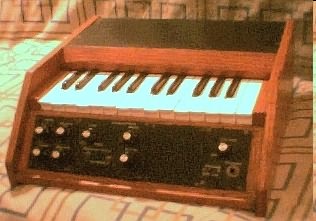Top Octave
|
This was a 2-octave keyboard instrument that used a 50240 top octave generator for full polyphony. The design 'borrowed' heavily from PAIA's Stringz-n-Thingz.
 Clocks Schematic Master Clock is a CMOS oscillator to clock the 50240. The 'Bend' pattern is borrowed from PAIA's Oz synth, which was also a top-octave instrument. Touching the Bend plate was supposed to add one's body capacitance to the circuit and thus bend the overall pitch of the instrument down. I didn't find it especially useful and omitted it from the finished project. A 74C93 4-bit ripple counter provides four octave ranges for the instrument. A ramp waveform is picked off the 555 timing cap Attack Clock and fed to an LM311 Comparator. This produced a variable width pulse for Attack sent to the keying circuits. These clocks and divider were on a sub-assembly that plugged into a 'backplane' made from a stripboard populated with .100" female connectors.
Top Octave and Top Note Schematic
A 74C74 divides 'Ch down 2 octaves and that squarewave is NANDed with a squarewave an octave higher. Each key produced 2 notes 2 octaves apart, which could be mixed, after keying, in a variable amount.
When no key is pressed, Attack pulses don't reach the 10uf capacitor and no voltage appears at the junctions of the oppositely facing diodes on the NAND gate outputs and so no signal reaches the Hs and Ls note busses. When a key is pressed, the capacitor charges up at a rate determined by the width of the Attack pulses -- theoretically. The resulting voltage is switched on and off by the NAND gate output and the result on the Hs and Ls note busses is a variable amplitude pulse. 'Decay connects to the wiper of a pot connected between +V and Gnd and thus sets the Decay or Release rate when a key is released. This variable width Attack wasn't entirely successful: long attacks were more like a delay in the start of a note than a slow rise. This taught me not to believe everything I read in Popular Electronics. PAIA's Stringz-n-Thingz used a fixed, 'soft' attack for the Stringz sound and a fixed, fast attack percussive envelope for the 'Piano.' (This diode method of controlling the height of digitally derived rectangular waves could be applied to sub-octave circuits. The amplitude-controling voltage must be no greater than the divider supply voltage.) Tone Generators Schematic Each of these boards were identical, the note they produced being determined by which connector they were plugged into on the stripboard 'backplane.' (I built a 13th tone generator as a spare. It's floating aound here somewhere.) The K0 attacks were from the lower octave of keys and K1s were from the upper octave of the 2-octave keyboard.
 I tried to put a SAD-1024 'Chorus' in this instrument, but that didn't work out too well, and I settled for a LM3900 bp VCF with LFO. The resulting instrument was pretty ho hum, I admit, but hey, polyphonic Casios were still years away, then. Status: Disassembled and canabalized * that isn't a typo |